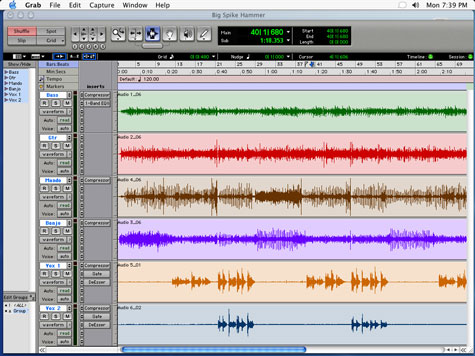
MAKING MUSIC A screen shot of a Pro Tools session. |
Drums in the living room, control room in the foyer, and guitar amps isolated in separate corners of the dining room — this is the shape of the modern low-budget studio.
With the advent of home recording technology, it has become increasingly easier for amateur musicians to put out a radio-ready, financially viable recording from the comfort of the living room couch. Software programs like Digidesign’s Pro Tools and Mac’s Logic have made it possible for the artist to run the whole show. For a few thousand dollars and a little bit of research on the internet, anyone can purchase the proper infrastructure for a home studio and the potential to produce a passable sounding recording in a few days.
So while advances in home recording technology have caused the sheer number of bands with recordings to skyrocket, they have also flooded the market with a lot of crap. Recording is a nuanced and intricate art. It takes more than just a computer and a guitar to create something worth listening to. According to Rory MacLeod, an experienced local musician who played bass for Roomful of Blues in the ’80s, recording “is all about the process. You can’t expect to go out, buy Pro Tools and churn out excellent work your first time through.”
These days, buying a locally recorded and produced album is a gamble. Because of the inverse relationship between the cost of recording programs and their accessibility to the public, the number of bands that book studio time has dropped precipitously, prompting studios to boost prices, pursue other avenues of income, or fold completely. Because there are less affordable studios available, bands are then forced to record themselves regardless of whether or not they have the capabilities. Some times, the DIY method works. Most of the time however, for one reason or another, it crashes and burns. Matt Corona of Run for Covers and White Noise Records had one explanation for why it is so hard for artists to record themselves: “There is nothing worse [for your music] than sitting in your practice space listening to your tracks by yourself.” When an artist is forced to be both the creator and judge of his or her work, it becomes impossible listen from a neutral standpoint and give good, productive criticism. “You limit yourself by not giving yourself access to a sec-ond set of ears. You can have all the great gear in the world, but in the end none of it matters if you don’t have someone else to bounce things off of. It’s all about the ears!”
So what does the influx of poorly recorded, poorly produced, and MySpace-marketed music mean for the local music scene? It means it’s harder than ever for a small-time band to make it big. Think about it — if a promoter has to sort through hundreds of worthless lumps of coal to find a single diamond, the likelihood of ever finding that diamond de-creases exponentially. Metaphor aside, Cody Silander of Sun Bears and the Loc Nar is a young veteran of several local bands and has quite a bit of experience recording from home. “When [Aenertia] did our first recording, we got lucky enough to be able to afford studio time at PM Recording in Wakefield. I think that being able to record in a real studio is definitely more impressive to people booking shows, yeah, I would say there is no question that it’s easier to get gigs with a studio recorded demo.”